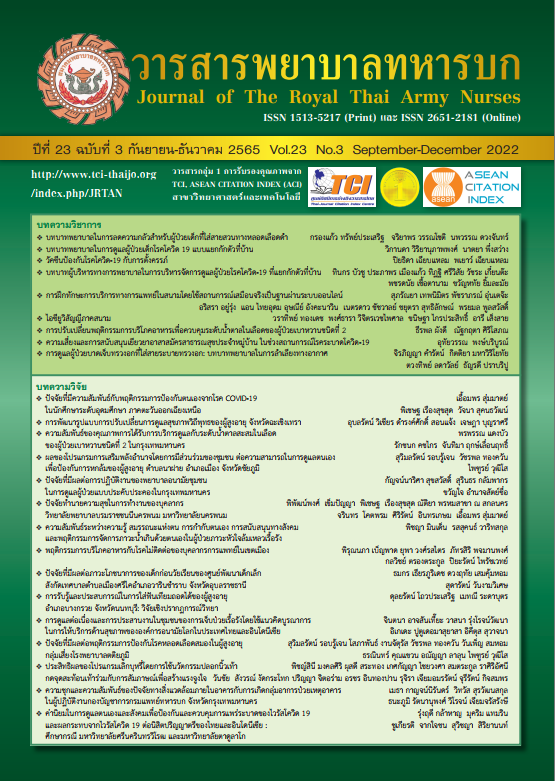Continuing and Coordinating Care in Communities of Chronic Illness by using WHO Concept of Integrated Centered Health Services in Thailand and Indonesia
Keywords:
Continuity and coordination of care, Chronic illness, WHO concept of integrated centered health servicesAbstract
A sequential explanatory design of mixed-method research explored continuing and coordinating care in communities of chronic illness by utilizing the World Health Organization (WHO) concept of centered patient healthcare services and to stimulate a strong community for sustainable and equilibrium of continuing and coordination of care. The target population was people with chronic illness and healthcare professionals, 160 samples came from 80 of each site. Each site was composed of 50 Participants with chronic illnesses and 30 people were representing community healthcare providers. Data collection and analysis started with quantitative data, then qualitative data in a second phase. The questionnaires for patients and healthcare providers were proposed to3 expertise for content validity was .96 and reliability for Cronbach’s Alpha at .98, .87 respectively. The content of the collected data was analyzed 1) in quantitative data; descriptive analysis; 2) Content analysis was used in qualitative data. Quantitative research results showed that continuing and coordination of care in Thailand and Indonesia were composed following 1. Continuing with a primary care professional had an average score of 3.82 ± .74 vs. 4.15 ± .83, 2) Collaboration in care and sharing decision-making scored on average 3.84 ± .79 and 4.25 ±.75, 3) Case management with complex needs was rated at 3.83 ± .75 compared to 4.21 ± .74 ; 4) Collocated services of access were rated at 3.67 ± .87 compared to 4.23 ±.74 5)Transitional or intermediate care had an average score of 3.66 ±1.48 vs. 4.16 ± .73, 6) Comprehensive care along the entire pathway had an average score of 3.78 ± .78 vs. 4.20 ± .78, 7) Technology in continuity and coordination of care had an average score at 3.54 ± .86 vs. 4.24 ± .74, 8) Building workforce capability had an average score at 3.76 ± .84 vs. 4.24 ± .74. Qualitative Research results showed the strengthened community for sustainability and equilibrium of continuing and coordination of care found that the system of caring was well-organized top to bottom and bottom to top, health volunteers with a high level of spirit, and a budget was to support the system.
It can be concluded that continuing and coordinating care in the community should have good systems, good organizations, financial support, the spirit of healthcare providers and the use of technology to provide information supporting care will increase sustainable programs for patients’ satisfaction and wellbeing. Moreover, the WHO concept of integrated health services will guide the healthcare providers to awareness to create a sustainable quality of life in the community.
Downloads
References
Ruan Y, Chen W, Zhuang C, & Lin H. HealthRelated Perceptions of Older Adults/Patients with Degenerative Lumbar Diseases (ODLs) are associated with their Quality of Life: a Mixed-Methods Study. 2021.DOI: 10.2147/PPA. S328532. PMID: 34675494; PMCID: PMC8518139.
Bauer UE, Briss PA, Goodman RA, & Bowman BA. Prevention of chronic disease in the 21st century: elimination of the leading preventable causes of premature death and disability in the USA. Lancet.2014; 5:384(9937):45-52. DOI: 10.1016/S0140- 6736(14)60648-6.
Polis S & Fernandez R. JBI. Database System Rev Implement Rep. 2015;13(1):39-51.
Pankong , O., Khrabiad, S., Amphawa, K., & Sangsee, P. Effectiveness of Care in Older Adults with Chronic Illness by Community Participation. Journal of Health and Nursing Research .2020;36(3): 94-104.
WHO & UNICEF. A vision for primary health care in the 21st century: towards universal health coverage and the Sustainable Development Goals. Geneva: World Health Organization.2018.
WHO, UNICEF. Integrated community case management. An equity-focused strategy to improve access to essential treatment services for children. New York City (NY): United Nations Children’s Fund.2012.
Daniel WW & Chad L.Cross. Biostatistics: A Foundation for Analysis in the Health Sciences. 10th edition.2013;189-192. New York: John Wiley & Sons.
WHO. Framework on integrated, people-centered health services. Report by the Secretariat (document A69/39). In: Sixty-ninth World Health Assembly, Geneva.2018.
Piseth N. & Charungkaittikul S. Proposed strategies to strengthen community participation in community learning centers in The Kingdom of Cambodia. Humanities, Arts and Social Sciences Studies (HASSS).2021; 21, (3):436-446.
World Health Organization. Noncommunicable Diseases Progress Monitor.2015. ISBN: 978 92 4 150945 9
Artsanthia J.& Pomthong R. Nurses’role: Case study of psychological care for Caregivers of Patients with Terminal Illness. Journal of the Royal Thai Army Nurses. 2018; 19 (1) :1-8. (in Thai).
Ursula E B, Peter A B, & Richard A G. Prevention of chronic disease in the 21st century: elimination of the leading preventable causes of premature death and disability in the USA.2014. DOI:https://doi.org/10.1016/S0140- 6736(14)60648-6
Parmar J, Jacqueline T, P, Lesley C., Karenn C., Peter G, J.T. Supporting Family Caregivers of Seniors within Acute and Continuing Care Systems. Canadian Geriatrics journal.2018; 21(4):292-296.
Artsanthia J. Palliative Care in community with the Buddhism traditions. Journal of the Royal Thai Army Nurses. 2013; 14 (1) :123-27. (in Thai).
Downloads
Published
How to Cite
Issue
Section
License
Copyright (c) 2022 Journal of The Royal Thai Army Nurses

This work is licensed under a Creative Commons Attribution-NonCommercial-NoDerivatives 4.0 International License.
บทความหรือข้อคิดเห็นใดใดที่ปรากฏในวารสารพยาบาลทหารบกเป็นวรรณกรรมของผู้เขียน ซึ่งบรรณาธิการหรือสมาคมพยาบาลทหารบก ไม่จำเป็นต้องเห็นด้วย
บทความที่ได้รับการตีพิมพ์เป็นลิขสิทธิ์ของวารสารพยาบาลทหารบก
The ideas and opinions expressed in the Journal of The Royal Thai Army Nurses are those of the authors and not necessarily those
of the editor or Royal Thai Army Nurses Association.






